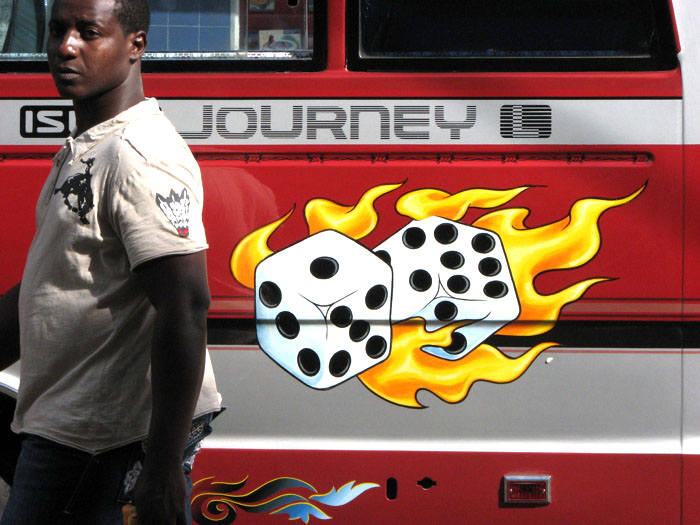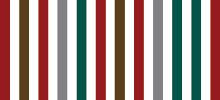
Let Them Talk (2009), by Risk Hazekamp
Risk Hazekamp is a Dutch artist based in Rotterdam and Berlin, and one of the participants in the ArtRoPa project. She offers some thoughts on one of the works inspired by her residency in Suriname in 2008.
I use photography to explore issues of identity, and in particular the way in which gender and identity intersect. By evoking and drawing upon mass media and popular visual language — fashion, advertising, and movie genres — I question the construction of (gender) identities.
In this image I place myself in the position of the exotic, the “stared at”, using an eclectic image language that will be read differently depending on the individual luggage of the viewer. At the same time the “stared at” takes back power by staring back at the viewer, and thus also becomes the active one.
For me, this picture contains a lot of personal thoughts and feelings. It functions as an expression of my encounter with Suriname (which is still going on). To highlight a few details/elements:
= Let Them Talk is the name of the specific angisa (headkerchief) in the photograph. [The angisa incorporates a form of visual language: the pattern of knots conveys a specific message, after which each angisa is named.] In Suriname, the angisa is mostly used to express personal feelings, but is it also used as a political tool?
= The angisa in this image is made from newspapers that were published the day after [Dutch politician] Pim Fortuyn was murdered. We can recognise him on the front of the angisa. The bandeau is made of the Surinamese newspaper De Ware Tijd (“The True Time”).
= The picture is a self-portrait, showing me, with my biological female body, dressed as a drag queen: a man performing femininity. It refers to Pim Fortuyn being a very outspoken, flamboyant homosexual individual, which in my opinion contradicts with his extreme, right-wing political points of view.
= The showing of intimate parts of the body is a statement in itself. Not only do I show here the “real” white skin of my body, my breast, against the artificially white skin of my face; in doing so I try to emphasise the fragility, the instability, and the fugacity of the human body.
One of the intellectual frameworks of this work is a book by the social and cultural anthropologist Gloria Wekker: The Politics of Passion: Women's Sexual Culture in the Afro-Surinamese Diaspora (2006). Wekker writes:
In Sranan Tongo ... there is a plethora of terms to make statements about “I”, pointing to the multiplicity and malleability of self....
One of the striking features of this scheme is that it is possible, irrespective of one’s gender, to make statements about self in one of three ways: first, in singular and/or in plural terms; second, in male and/or female terms.... In addition to these different terms, there is a third mode to make statements about self in terms of third-person constructions, i.e., in terms of one’s Winti....
With this photograph I want to express the crux of my work, which is that identity should not be understood as a logical and coherent thing, but as something that is dynamic, fragmented, and a changeable process that is constantly moving.
Project: Risk Hazekamp, Let Them Talk
Monday, September 28, 2009
Labels: artropa, photography, project, risk hazekamp
In Memoriam: Henk Tjon (1948-2009)
Sunday, September 20, 2009
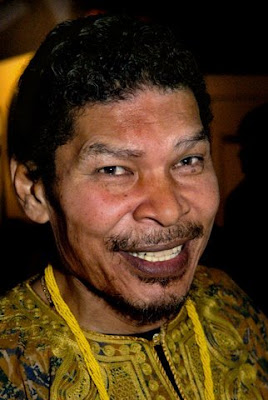
Portrait of Henk Tjon courtesy De Nieuw Amsterdam
Henk Tjon – Suriname's most celebrated theatre director, playwright, and cultural activist – died in Paramaribo on 18 September, at the age of 61. He played a major role in sharing Surinamese culture with the rest of the Caribbean – especially via the Caribbean Festival of Arts, Carifesta, for which he served as Suriname's artistic director seven times over nearly four decades. He was also the co-founder of De Nieuw Amsterdam (DNA) theatre company in the Netherlands.
In 2007, Tjon wrote:
As an active theatre maker in a post-colonial environment, you really have no choice in what kind of theatre you make. You will always want to bring people together with your work, want to stimulate exchange and cohesion between people and their cultures. Naturally, your immediate environment will determine your work to a significant degree, but what all theatre makers who do not work in the West have in common is the fact that they are usually not working for the elite. Whether you are working in India, Uganda, Suriname or Ecuador, theatre is in the middle of society. That is also what gives it a lot of its expressive power.
Personally, the artistic urge has always been my primary drive. But what I hope to achieve with my theatre also applies to those who use theatre as a means to achieve other objectives. We all want to communicate, to touch others, to get people thinking. That will always be the most important function of the theatre. Sadly, all of us former colonies carry an annoying history with us. The fact that others determined how and who we were for us – we have not been liberated from that yet. It will play a large part for a long time.
In the search for identity, theatre has an important function.
Labels: henk tjon, in memoriam, theatre
Meanwhile: September and October 2009
Friday, September 18, 2009
Notes on other current and upcoming art events in Suriname and elsewhere
Entangled Red and Blue (acrylic on canvas, 102 x 82 cm, 1993), by Erwin de Vries. Image courtesy Kunsthal Rotterdam
= Tribute to the Woman: Erwin de Vries
Kunsthal Rotterdam; 12 September to 29 November, 2009
An exhibition celebrating the eightieth birthday of one of Suriname's elder artists. Over 150 paintings, drawings, and sculptures dating from the 1950s to the present offer an overview of de Vries's oeuvre. In December 2009 the show will move to Fort Zeelandia, Paramaribo.
Poster for the Rotterdam exhibition of new work by Ravi Rajcoomar and Roddney Tjon Poen Gie
= Suriname: Ravi Rajcoomar and Roddney Tjon Poen Gie
Centrum Beeldende Kunst, Rotterdam; 19 September to 11 October, 2009
New works produced by two Surinamese artists during their recent ArtRoPa residencies in Rotterdam.
Labels: de vries, meanwhile, rajcoomar, tjon poen gie
Topography: minibus, Maagdenstraat
Tuesday, September 15, 2009
Labels: maagdenstraat, minibus, street painting, topography
Project: Patricia Kaersenhout, Invisible Men
Friday, September 11, 2009

Patricia Kaersenhout is a Surinamese artist based in Amsterdam. She recently participated in the Wakaman Project, which brought Surinamese artists working at home and abroad into a conversation about contemporary art. “As an artist I’m in a constant state of becoming,” she writes, “therefore my work can never be a finished product.... When a work is recognizable, sellable, suitable, please-able it contains too many ‘ables’. For me the only ‘able’ that coincides with my work is dis-able.”
Kaersenhout's most recent project is Invisible Men, a book of images and words inspired by Ralph Ellison's novel of (almost) the same name. Using the pages of an old biology textbook as her staring-point, she “tries to visualize the invisible; from spirit to flesh.”
From writer Eva van Leeuwen's text in Invisible Men:
You are standing really still behind the curtain. You hear people walking by, calling out, doors being opened and closed again. Being invisible seemed like the most wonderful thing imaginable.
Until that one particular day, when you hear nobody walking by and there is no calling out. You must have been standing really still behind the curtain for at least thirty minutes. It slowly dawns on you: there is nobody looking for me. And suddenly it was no longer any fun.
Perhaps you can only be invisible if you are being looked for. If you are not being sought then you simply don’t exist. And what if you are searching for an invisible someone but nobody is searching for you? Who is actually invisible then?
Invisible Men is published in a limited edition by Eindeloos. For more information, or to buy a copy, visit the publishers’ website. See more of the book here.
Labels: book, kaersenhout, project, wakaman
Document: Afaka's first letter
Wednesday, September 9, 2009

ke mi gadu | mi masa | mi bigi na ini a ulotu | fu a papila di yu be gi afaka...
It's estimated there are 25,000 to 30,000 speakers of Djuka (or Ndyuka), one of the Maroon languages of Suriname and French Guiana. Derived from English and several West African languages, Djuka has three distinct spoken dialects as well as a written form, called Afaka script after its creator.
Afaka Atumisi was a Djuka from the Tapanahony region of south-eastern Suriname. Circa 1910 -- inspired, he said, by a dream or vision -- he invented a syllabary of 56 characters which allowed Djuka texts to be recorded and transmitted in writing. Afaka died in 1918, but by 1920 it was reported that over a hundred people in the Tapanahony area could read and write his script.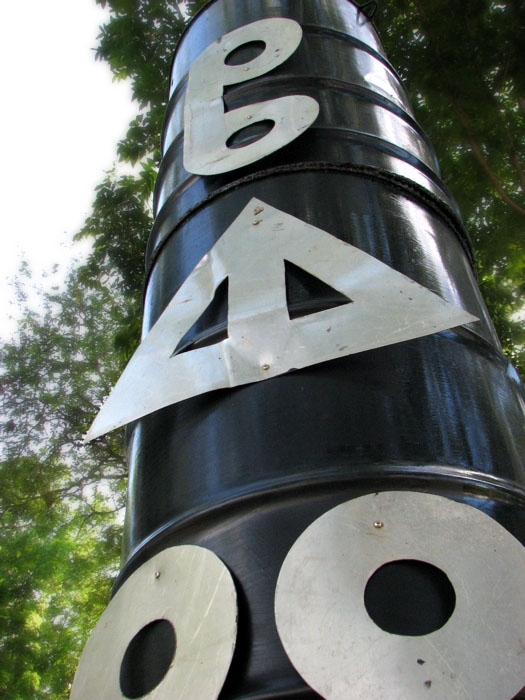
Detail of one of Marcel Pinas's Kibi Wi totems, made from oil drums decorated with aluminium Afaka characters; Fort Zeelandia, Paramaribo, April 2009. Photo by Nicholas Laughlin
In later decades, the number of fluent readers and writers declined -- an article in the Suriname Museum journal in 1975 estimated that "most probably there remain only five." But more recently Afaka script, like other elements of Maroon culture, has been increasingly adopted (and adapted) as a symbol of Surinamese national identity, and the script is not an unfamiliar sight in Paramaribo. Afaka characters are a recurring and assertive motif in the work of Marcel Pinas, a member of the Djuka community in Moengo, but Surinamese artists from other ethnic backgrounds -- including Roddney Tjon Poen Gie and Sri Irodikromo -- also use the script in their exploration of the country's ethnic intricacies.
Air Borne (acrylic on canvas, 67 x 100 cm, 2009), by Roddney Tjon Poen Gie; photo by William Tsang, courtesy Readytex Art Gallery.
"Tjon Poen Gie is well known for using his own visual language, which is based upon the letter symbols of his ancestors," says the Readytex Gallery website." He draws the characters and symbols three-dimensionally and thus produces a playful abstraction of Chinese letters and Afro Surinamese Afaka symbols in his artwork."
The document reproduced at the top of this post is one of the earliest surviving texts written in Afaka script -- a letter by Afaka Atumisi which reports on his unsuccessful trip to the hospital in Paramaribo in search of treatment. Read a full translation here.
Labels: afaka, document, irodikromo, language, pinas, tjon poen gie
Seen: Trefossa, by Ida Does
Saturday, September 5, 2009
Opening sequences from Trefossa: Mi a No Mi (2008), directed by Ida Does
Mi a no mi
solanga mi brudu
fu yu a n'e trubu
na ini den dusun titei fu mi
I am not myself
until my blood
is infused with you
in all of my veins
— From "Gronmama" ("Earthmother"); English translation by Quinton Zondervan
If Suriname has a national poet, Henri Frans de Ziel (1916-1975), who wrote under the pseudonym Trefossa, is perhaps the leading candidate. His groundbreaking 1957 book Trotji, the first published collection of Sranan poems, has been called "the big bang of Surinamese literature." Thousands of Surinamese schoolchildren sing his verse daily — he wrote the Sranan part of the national anthem.
Trefossa: Mi a No Mi (2008), a documentary by filmmakers Ida Does and Paul van den Bos, uses interviews, historic film footage, and Trefossa's own words — from his published poems and unpublished diaries — to tell his story, chart his influence on two generations of Surinamese writers, and investigate how the power of his poems helped legitimise Sranan Tongo in both Suriname and the Netherlands.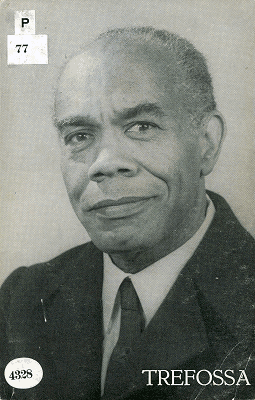
Portrait of Trefossa courtesy the DBNL
The text of Ala Poewema foe Trefossa ("Collected Poems of Trefossa", 1977) is available online at the Digitale Bibliotheek voor de Nederlandse Letteren.
Response: some thoughts on Someni Tongo
Wednesday, September 2, 2009

Part of the audience at the performance of Someni Tongo in the Palmentuin, 29 November, 2008
Just over two weeks ago, Paramaribo SPAN posted information on Dutch artist Arnold Schalks's Someni Tongo project (2008), which examined Suriname's cultural and linguistic diversity through a live performance of a celebrated poem. The comments left on the original post raised interesting questions about how this and other art projects are (or could or should be) received and interpreted by audiences and the wider art community.
Writer Chandra van Binnendijk, who witnessed the live performance of Someni Tongo, offers her personal response to the project and the resulting discussion.
I was one of the handful of people on that early Sunday morning in the Palmentuin nine months ago, there to watch the performance of Someni Tongo. There was a kind of silent conspiracy-like feeling, for being together for the event. The ones with cameras wanted to take pictures, but the best angle near the podium was not approachable: a vagrant had left a fresh turd right in that spot. And the manager of the Palmentuin refused to clean it up, for this was not his duty, he said.
It did not bother us at all: we placed an old newspaper on top of it, we warned others not to step on it, we moved around a little until everyone found his best place around the podium, and then we watched and experienced and enjoyed the Someni Tongo performance. All those tongues, speaking in all those different languages, expressing the same lines -- it was special, it was beautiful, and more so because we were there for the live experience.
The audience that morning left the Palmentuin with a feeling of upliftment, of contentment.
Shouldn't a similar feeling of contentment remain with the one who created this beautiful experience? What happens to the artist when he is so attached to the fruit of his work that he feels disappointed when response and feedback from the public are not what he expects (or even feels he deserved)? When he is not praised or imitated? Where is the pure joy of creating?
I think art is exactly and only about this: the need to create and express what is uniquely inside you, and to do so because you have no choice. Something is envisioned, it wants to come into the world through you, and it can only be born through your effort. Full stop. No ulterior motives. Creation is making art -- not the aftermath.
Someni Tongo was beautiful. But in its significance it was not unprecedented. Over the years, Suriname has seen high-level performances of multi-racial, muli-ethnic, and multi-lingual performances. One example is the theatrical production Rebirth, by director Henk Tjon, which was presented at Carifesta 1981 in Barbados, with a dazzling combination and integration of all these aspects. There have been performances by the National Ballet of Suriname choreographed by Ilse-Marie Hajary, who created the Dogla style, in which she integrated Afro drumming and winti elements with classical Indian dance movements.
So multi-culti is not really new for us. One should not overlook history -- we are able to reach heights because we are standing on the shoulders of those before us. Tjon and Hajary were not greeted with lavish standing ovations -- their work was not understood at first. This takes time.
On that beautiful mormning in the Palmentuin, we did not let the turd disturb us. Because the performance was compelling. The experience was enough.
Art in itself is enough.
Labels: performance, poem, response, schalks, van binnendijk


